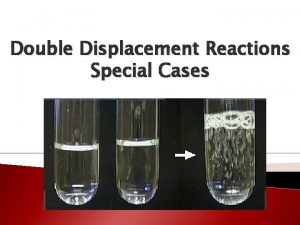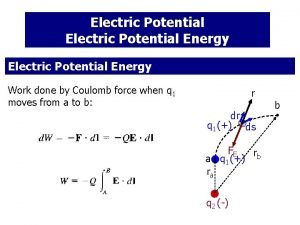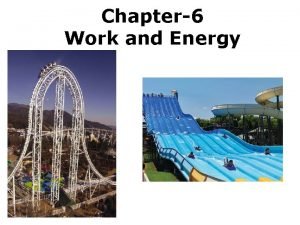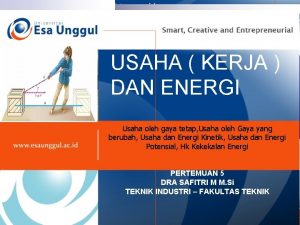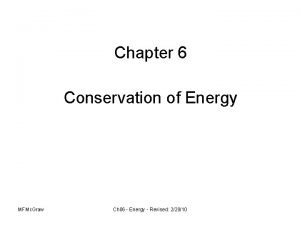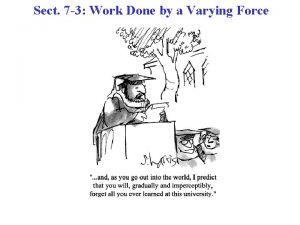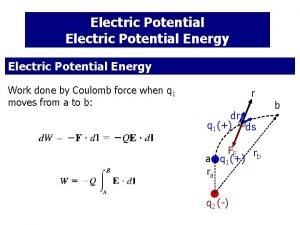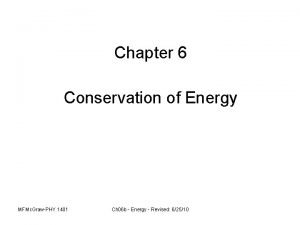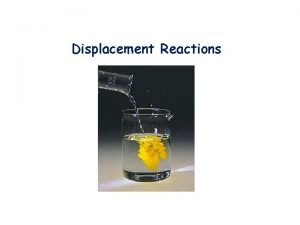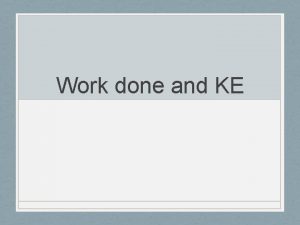Last lecture Work displacement force Work work done







- Slides: 7

Last lecture … Work = displacement * force -Work = work done by a force on an object -Displacement = displacement of the object -Force = component of a force on the object in the direction of the displacement Work-Energy Theorem - If the total work done on some object by all forces is positive, the object speeds up. - If the total work done on some object by all forces is negative, the object slows down.

Simple electrical circuits Context: How do I make a light bulb light up? Definition: A simple electric circuit consists of -a current source, such as a car battery -a resistor, such as a light bulb, or heater Example: A simple circuit: A battery creates an voltage V which pushes the current i through the resistor R. Lecture demo: -Battery and light bulb - Blow a fuse

Discussion: - Conventional current was defined early in the history of electrical science as a flow of positive charge. In solid metals, like wires, the positive charge carriers are immobile, and only the negatively charged electrons flow. Because the electron carries negative charge, the electron current is in the direction opposite to that of conventional (or electric) current. In other conductive materials, the electric current is due to the flow of charged particles in both directions at the same time. Electric currents in solutions (such as salt water) are flows of electrically charged atoms (ions), which exist in both positive and negative varieties. Electric currents in plasma are flows of electrons as well as positive and negative ions. In ice and in certain solid electrolytes, flowing protons constitute the electric current. Lecture demos: -Salt water circuit - Pickle circuit - Plasma ball Unit for current: Amperes A

Current Sources - Batteries (two chemicals –red&gray) - Capacitors (two metallic objects) - Rubbing of two different materials - Squeezing - Thermo couples (temperature difference) - Generator - Electrical outlet batteries

Wires - No voltage drop along a wire, constant voltage along a wire - No charge is lost, constant current along a wire

Resistors Definition: A resistor is a two-terminal electrical component that opposes an electric current by producing a voltage drop between its terminals. Non-metallic resistor Ohm’s law: Voltage drop = Resistance * Current Unit of resistance: Ohm Examples: light bulbs, long thin wires, non-metallic materials Discussion: -Resistance depends on temperature -Resistors produce heat & light Power = (voltage drop) * Current Lecture demos: -Resistor model - Resistors produce hat & light - low temperature demo. physics. uiuc. edu/lectdemo -Light bulbs in parallel and in series -Charges flow like a liquid: current = volume/time voltage = pressure

Simple electrical circuits A simple electric circuit consists of -a current source, such as a car battery -a resistor, such as a light bulb, or heater Voltage drop = Resistance * Current Power = (Voltage drop) * Current A simple circuit: A battery creates an voltage V which pushes the current i through the resistor R. In the wires, voltage and current are constant. Units: Current in Amperes A Voltage in Volts V Resistance in Ohm Ω
